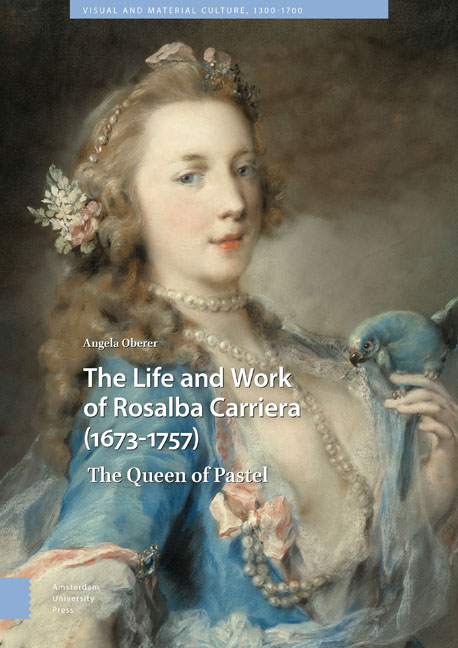Book contents
- Frontmatter
- Contents
- List of Figures and Plates
- Introduction
- 1 Rosalba Carriera – An Independent Single Artist in Eighteenth-Century Venice
- 2 Carriera's Discovery of Pastel Painting
- 3 Carriera's International Network
- 4 Carriera's Stay in Paris
- 5 Carriera's Oeuvre in Pastel
- 6 The Single Woman, the Spinster
- 7 Carriera's Last Journeys – The End of an E`nviable Career
- 8 Carriera's Ways of Self-Fashioning
- Conclusion
- Bibliography
- Index
6 - The Single Woman, the Spinster
Published online by Cambridge University Press: 24 November 2020
- Frontmatter
- Contents
- List of Figures and Plates
- Introduction
- 1 Rosalba Carriera – An Independent Single Artist in Eighteenth-Century Venice
- 2 Carriera's Discovery of Pastel Painting
- 3 Carriera's International Network
- 4 Carriera's Stay in Paris
- 5 Carriera's Oeuvre in Pastel
- 6 The Single Woman, the Spinster
- 7 Carriera's Last Journeys – The End of an E`nviable Career
- 8 Carriera's Ways of Self-Fashioning
- Conclusion
- Bibliography
- Index
Summary
On 26 June 1703, Ferdinando Maria Nicoli from Bologna wrote in a letter to Carriera:
I don't know who it was who said: what good luck for a painter to have so virtuous an artistic emulatress for a spouse; to which he replied that, in order to properly find her match, one would have to resuscitate Signor Guido Reni.
Nicoli's words convey a form of recognition quite in keeping with the tradition of artistic competition. Coming from Bologna, home of the and highly regarded painter Guido Reni (1575–1642), this comparison was doubly flattering to Carriera. Yet Nicoli touches on the artist's celibacy, an aspect of her private life that was often a topic of discussion among her contemporaries and biographers. Not only did Carriera's resolute choice mean swimming against current conventions as well as finding a role and an identity for a social group not officially acknowledged to exist, but it also entailed renouncing the predefined role of the wife who receives financial and social support, and protection from her husband. It was a decision that carried along with it certain threats.
As Adrienne Ward has stated, even with fathers present,
unmarried daughters of a certain age embodied the nexus of several potential instabilities, risks to domestic and communal order. They could compromise family honour, disrupt estate succession, confuse relations between families, and stain community morality.
It is worthwhile examining not only the consequences but also the possible reasons behind Carriera's decision not to enter into marriage, and to take a closer look at the social network which she constructed for herself to compensate for the loss of the system that excluded her as a single woman.
As in her career, Carriera chose independence in her private life, remaining alone and never marrying. It was a choice that made her part of a tiny minority of the society she lived in. Fewer than 10 per cent of eighteenth-century women remained spinsters. Nevertheless, among the group of female artists she took on a quite representative role as the seventeenth and eighteenth centuries produced a striking number of female painters who also remained unmarried, such as Giovanna Garzoni (1600–1670), Chiara Varotari (1600–1660), Maria van Oosterwijck (1630–1693), Elisabetta Sirani and Giulia Lama, to name just a few.
- Type
- Chapter
- Information
- Life and Work of Rosalba Carriera (1673–1757)The Queen of Pastel, pp. 217 - 248Publisher: Amsterdam University PressPrint publication year: 2020

